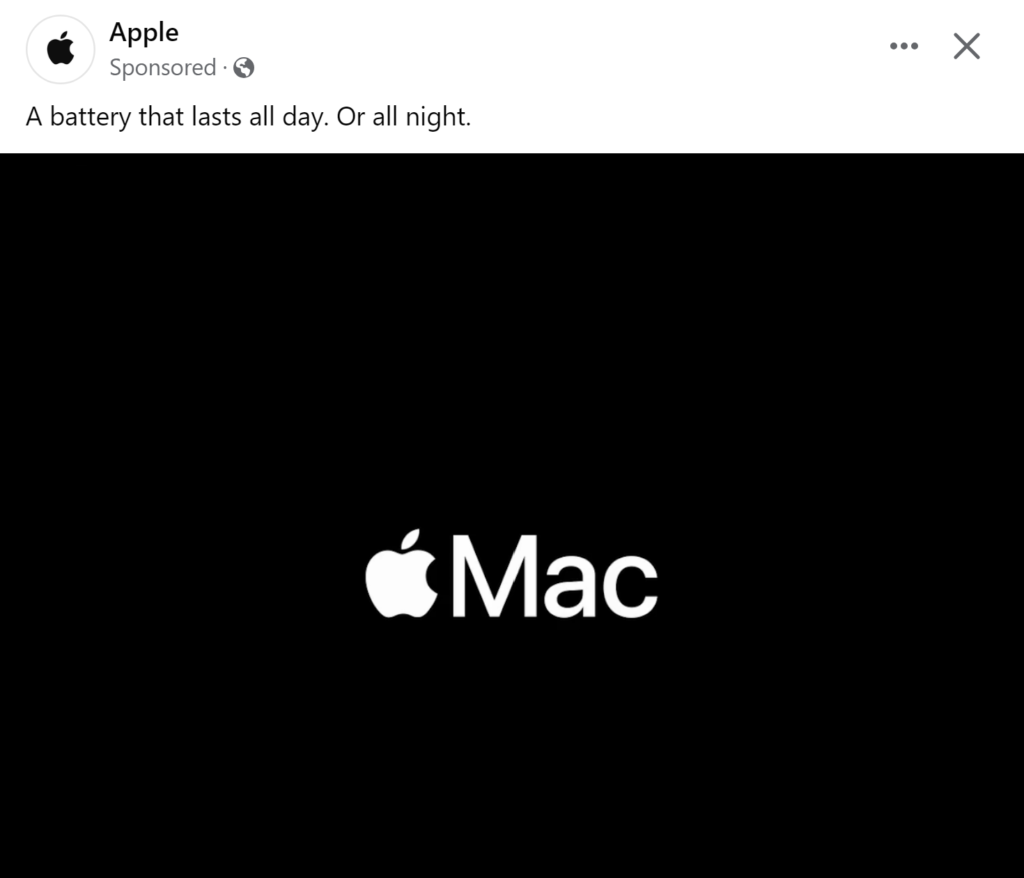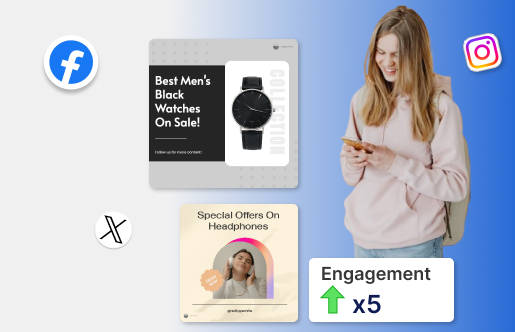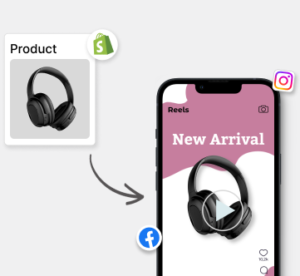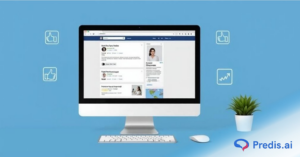If you’re an avid social media user, you’ve probably come across ads that almost seem like they’ve been tailor-made for you. Whether it’s a pair of sneakers or the latest in tech, algorithms have developed an uncanny ability to predict your needs and display relevant ads based on the same to earn your business.
A lot happens behind the scenes on these platforms, with their continually fine-tuned, AI-enhanced systems becoming increasingly indispensable for big brands and small businesses alike. It’s easy to get started, with small initial investments, and the returns generated can be substantial when done right.
Social media advertising is an art, just as much as it is a science; one that requires patience and effort while making use of tried and tested scientific principles. In this article, we unpack everything there is on social media advertising, its costs, returns, and challenges to best guide you through this maze.
Understanding Social Media Advertising
In the early 2000s, when social media first arrived on the scene, the platforms were like the Wild West; new, uncharted territories free from rules and restrictions of any kind.
Things have since changed drastically, and they’re now highly sophisticated marketplaces with extensive moderation and algorithmic rules that can make or break an advertising campaign. They, however, continue to host massive amounts of user engagement, making them indispensable for businesses.
No matter what business you run, if your potential customers use the internet, they’re probably on social media. You’re missing out on a lot of business by not using this form of advertising as part of your marketing mix.
Now, with the massive amounts of data that these platforms collect from their users and the remarkable new capabilities of AI and machine learning, many platforms, such as Facebook Ads, will actively seek out potential targets and customers for your brand.
Most social media platforms, especially Facebook, maintain a vast repository of data on their users, having recorded their likes, dislikes, and other forms of engagement. Using this data, the platform can help advertisers automatically target users that it thinks will lead to the most engagement and sales.
Types of Social Media Advertising
Social media advertising comes in various shapes and sizes. Just Facebook alone offers a wide variety of ad formats and options, which work differently depending on the niche, industry, and target audiences.
Most marketers and advertisers make it a point to try out all the options available to them before collecting sufficient data and doubling down on the one that works best. This might be an expensive approach but it’s essential for campaigns to generate good ROIs and attain profitability.
For instance, there are times when an ad campaign or creative does not perform well on mobile devices but could generate good results when restricted to just desktop traffic. Data is the lifeblood of this business, and you would do well to try and get your hands on as much of it as possible.
There’s a whole palette of ad types at a marketer’s disposal, here’s our brief take on the most prominent ones,
1. Display ads
Display ads are the old warhorses of digital marketing that have been around since the early days of the Internet. They continue to retain their broad appeal and do a great job when it comes to attracting user attention.
They come in different shapes and sizes and can be placed in different corners of a website. Most social media sites don’t feature display ads, as they deem them to be too intrusive, and they often don’t play along with the broader schemes of their respective platforms.
Advertisers can choose between a CPM (cost-per-thousand impressions) or CPC (cost-per-click) ad, depending on the nature of their campaign, budget, and other factors. Like in the case of most ads, your creatives, alongside continuous optimization are key for this format.
Want to make the best display ads for your products? Try Predis.ai's Display Ad Maker!
2. Sponsored content

Sponsored content feels less like an ad and more like part of the flow, making it great for engagement. They are also referred to as native ads, as users don’t always recognize them as being ads, which once again, works great for driving clicks and engagement.
This is the kind of ad that Facebook has pioneered over the years, and it works remarkably well on the timelines of its nearly 3 billion monthly active users.
You will, however, compete with millions of other advertisers vying to put their ads in front of the same audiences that you’re targeting.
The key here is once again, high-quality creatives, coupled with patient and steady campaign optimization. Facebook’s powerful AI will try its best to get you off to a flying start, and by using it well, you can turn pretty much any campaign profitable in the medium to long run.
3. Influencer Marketing

This type of advertising includes partnerships that leverage the credibility and audience of well-known personalities, either in the form of shout-outs, or organic brand promotions, placements, and exposure.
This is another form of native advertising, one that takes things further, relying entirely on the trust and credibility of power users on social media platforms.
For instance, getting your product reviewed by Marques Brownlee can help kickstart a viral chain that no amount of traditional advertising can buy, resulting in significantly better sales, conversions, and brand exposure.
Create captivating TikTok ads that capture attention and drive action with Predis.ai’s TikTok Ad Maker. Generate branded ads that can increase clicks and conversions.
4. Videos
A video ad is quite similar to display ads, or at least it uses a mechanism that is similar to display ad distribution on platforms such as Facebook, Instagram, and Pinterest, among others.
Videos capture attention a lot better than display ads, and can also better convey intent and information pertaining to products, but crafting videos, whether live-action or animation can be expensive, and not in the budget of most small businesses.
5. Shoppable Ads
eCommerce is getting increasingly intertwined with social media, and platforms such as Facebook, Instagram, and Pinterest are going all-out on this trend.
If you run an e-commerce store or sell your own product, it can now be directly integrated with your ads. eCom platforms such as Shopify now allow this, and it will soon be possible for users to checkout products on Facebook without having to leave the site.
For certain low-value products, which can demonstrated well enough via the banner creative or video, sales via this method can prove to be very profitable.
Use Predis.ai's Banner Maker for stunning banner ads!
Key Platforms For Social Media Advertising
Each social media platform offers a unique flavor for advertising,
- Facebook & Instagram: The behemoths. Ideal for reaching a massive, diverse audience with highly targeted ads.
- Twitter: Quick and snappy, perfect for timely promotions.
- LinkedIn: The go-to for B2B marketing, with every college grad to c-suite executive maintaining an active presence and being reachable.
- Snapchat: Great for a younger demographic, with ads that are fun and engaging.
- TikTok: The wild card, perfect for viral content and reaching a young, trend-savvy audience. Though its future remains uncertain, it offers a robust prospect for marketers and business owners at the present.
Cost of Social Media Advertising
On the face of it, social media advertising might come off as expensive when compared to traditional advertising options. This is, however, only based on the gross number of people reached, while completely discounting the targeting capabilities of social media ads.
Traditional ads might help you reach a massive audience for a small fee on a per capita basis. With targeted social media ads, you are essentially reaching a handful of users. However, they come with a high probability of converting into sales and leads.
As mentioned before, social media advertising is a science in and of itself, with plenty of principles and tried-and-tested best practices to deliver optimal results. Here are a few factors to consider when budgeting and planning a social media campaign.
Factors Influencing Advertising Costs
Not all ads are created equal, and neither are their costs. Choosing where to advertise, what format to use, whom to target, and when to run your ads can all dramatically affect your budget.
Want to target high-income millennials at 8 PM on a Friday? That’ll cost you. However understanding these factors can help you make the most of your budget.
It’s all about demand and supply. So while you’re targeting your ads, there are a million other advertisers vying for the exact same demographic. This increases the overall CPM or CPC rates. Consider making changes to your targeting strategy and see the difference it makes to your advertising costs.
Budgeting For Social Media Ads
When it comes to online ad campaigns for small businesses, every dollar has to scream for attention, while big brands might play a longer game. Strategies differ wildly depending on your end goal and the depth of your pockets, but it is essential to get started with at least a few hundred dollars in capital.
Having sufficient funds allows you to test and gather sufficient data. This can then be used to optimize and turn campaigns profitable. Without this, you only stand to lose whatever small amount of money you have dedicated to advertising.
It is also essential to spread your budget over an extended period of time, and not let the campaign blow through it right away. This further plays into the strategy of capturing data and having plenty of time to optimize and test different variations.
Cost-Effective Social Media Advertising Strategies
A key disadvantage of social media campaigns is that you can run through your budgets before you realize what hit you.
While there are options to limit your daily spending, conserving your spending should ideally go beyond this. Small marketers and businesses especially should strive to stretch their ad dollars as far as they possibly can.
A great way to do this is by switching between cost-per-click and cost-per-impression formats, working with the one that yields the most savings.
In addition to this, you can consider building your organic reach while advertising. This means acquiring followers, fans, and likes on the platforms so that you have another source of traffic beyond just paid clicks.
Measuring ROI In Social Media Advertising
Tracking and analysis are crucial for getting results with social media advertising. Without this, your marketing endeavors largely rely on a prayer and a wing. This rarely works out in the long run, especially when working in today’s hyper-competitive landscape.
In addition to ascertaining the immediate return on investment from your campaigns by pegging sales against spend, businesses should also consider other qualitative and long-term factors. These include growing brand exposure, customer engagement, and overall market influence.
Defining & Calculating ROI
Why bother with social media advertising? Simple: the return on investment (ROI) can be substantial. But first, you’ve got to know how to measure it. ROI in social media isn’t just about dollars earned, it’s also about engagement, brand reach, and customer loyalty.
We’ll break down which social media metrics matter most (think conversion rates and engagement levels) and how to tie them back to your bottom line.
1. Conversion Rates
This essentially defines the percentage of users who accomplish a desired action after engaging with your ad. This can be anything, from subscribing to your newsletter to making a purchase or downloading an app.
2. Engagement Levels
This includes likes, comments, shares, and overall interactions with your ads. High engagement rates often indicate strong content resonance with your target audience, which can boost brand loyalty and customer retention.
Social media platforms essentially live and breathe engagement. Even in the case of advertising, those that are the most engaging stand to work the best.
3. Cost Per Acquisition (CPA)
How much does it cost to acquire a customer through your social media campaign? This metric helps you understand the financial efficiency of your ad spend.
The calculation for this is fairly straightforward. The total cost of the campaign is divided by the total number of new customers, leads, or actions generated. To streamline payment processing and reduce manual work associated with incoming cash, implementing Cash Application Automation Software ensures faster reconciliation, improves accuracy, and provides better insight into revenue generated per customer.
4. Customer Lifetime Value (CLV)
This measures the total revenue a business can reasonably expect from a single customer account throughout the business relationship.
Comparing CLV to CPA provides insight into the long-term value of social media advertising campaigns. This may not be immediately profitable but might turn positive over the course of a customer’s lifecycle with your product, brand, or business.
5. Brand Awareness & Reach
These are more diffuse metrics that gauge how widely your brand is being seen. Impressions, the number of times your ad is seen, and reach, the number of unique viewers, are key indicators.
Increasing brand awareness is often a precursor to more direct financial gains. A great way to track branding gains from ad campaigns is by checking for the increase in branded searches in Google and other search engines.
This implies that people are directly searching for your business, brand, or product, as opposed to being referred to from some other ad or site.
Boost Sales on Social Media with AI⚡️
TRY NOWTools & Technologies For Tracking ROI
Staying on top of your game means knowing the tools of the trade. There are a ton of analytics tools out there that can help you track everything from clicks to conversions.
Integrating this data with your sales figures or connecting it to CRM software for e-commerce can give you a clear picture of how your ads are performing. And yes, this might mean getting a bit friendly with data analytics tools like Google Analytics, Facebook Insights, or even more sophisticated CRM software. Platforms like ThoughtSpot bring an added advantage , offering agent-powered, real-time insights that let marketers explore ad performance and uncover trends instantly.
These tools are usually hooked up to leading analytics dashboards, such as Power BI or MixPanel. This keeps managers and marketers in the loop regarding the performance of their campaigns. Any changes required can be made right away.
Challenges In Social Media Advertising
Navigating the world of social media advertising isn’t all smooth sailing. From ever-evolving platform algorithms that can hide or highlight your content unpredictably, to the fatigue that sets in when users see one too many ads, marketers face a series of hurdles.
This section delves into these challenges, including the tightening grip of privacy regulations and the critical need for effective crisis management, offering insights on how to tackle these obstacles head-on.
1. Navigating Algorithm Changes
If there is one thing that social media platforms have become notorious for in recent years, it is their out-of-the-blue algorithmic changes. These can pretty much trounce a small business if it is too reliant on these platforms.
Many former high-fliers on Facebook, who used to garner tens of millions in organic views each month, were pretty much buried overnight when the social media platform made changes to its algorithm, reducing the organic reach of new content substantially.
So, if you’re running campaigns with the hopes of garnering likes and followers, which can boost your organic reach over time, you might be in for a surprise at the very end.
The best way to navigate this is by taking your audiences out of the platform. This can be done either by getting them to sign up for your newsletter or by sharing other contact details. This allows you to continue to reach them.
2. Dealing With Ad Fatigue
Ad fatigue is real. When your audience sees the same ad one too many times, engagement drops, and your ads become less effective. Ad fatigue is also caused by seeing way too many ads, which causes users to simply tune off when shown another ad, which severely impacts your engagement and conversions.
This necessitates an ad strategy that involves constantly using different variations to stand out and get users to notice. Of course, this isn’t easy, and is rather a laborious process, coming with multiple ad formats, and new designs every few weeks to maintain your campaign’s performance.
Tools such as Predis.ai can come in handy here, allowing you to churn out new creatives and ad content fairly easily, without requiring much design experience.
Another great way to deal with this issue is by running ads on a schedule or implementing day parting, where your ads only run on days during which data has shown that it receives the best response.
This ensures that people aren’t constantly bombarded with your ads and that there is some novelty still being maintained.
3. Privacy & Regulatory Challenges
With great power comes great responsibility. The more targeted your ads, the more you tread on thin ice with privacy issues. Regulations such as GDPR in Europe and the CCPA in California are already weighing down on this industry and its many practices that border on the unethical.
Platforms like Facebook and Instagram no longer allow political ads and increase their moderation efforts manifold during election seasons. If your ad or its creative even gives a slight whiff of being political, it will either get buried or not be allowed to run at all.
There are no workarounds for this, and the only thing that can be done in this regard is to be mindful of the terms and conditions of the different ad platforms you use. You should also know the laws, regulations, and privacy rights accrued to consumers, and try your best to abide by them.
4. Crisis Management in Social Media
Ever seen a brand mishandle a crisis on social media? It’s not pretty. But with the right strategies, even a potential PR disaster can be managed, or better yet, avoided. Effective crisis management on social media requires both proactive and reactive strategies.
Brands should proactively establish a clear policy for handling potential crises. This includes monitoring social media channels for any signs of trouble, such as sudden spikes in negative feedback. This allows for rapid response before the issue escalates.
Reactively, once a crisis hits, the key is swift and transparent communication. Addressing the issue head-on with honesty shows accountability and can often defuse tension.
Importantly, adapting your response to the nature of the crisis, whether it’s a misinterpreted ad or a faulty product, helps tailor your message to the audience’s concerns, potentially turning a bad situation into an opportunity to demonstrate your brand’s values and commitment to customer satisfaction.
Conclusion
Social media advertising is a vast and dynamic field that keeps marketers on their toes. From managing budgets and calculating ROI to navigating privacy laws and staying relevant amidst algorithm changes, there’s always something new to learn. But the payoff can be massive.
Whether you’re a small startup or a large corporation, mastering social media advertising can catapult your brand to new heights, provided that you play your cards well, and don’t get too greedy or high-handed when dealing with platforms and their users.
Want to create the best social media ads for boosting your conversion rates? Sign up for Predis.ai today and experience the magic of AI-powered tools!
Related Content,
Best Social Media Ad Examples for Your Next Campaign

















